A wave of Ukrainian long-range weapons widely reported to be around a dozen US-made ATACMS ballistic missiles pounded air bases and air defense installations across Crimea peninsula early Tuesday morning, in one of the beefiest Armed Forces of Ukraine (AFU) long-range attacks yet against the Kremlin-occupied territory.
Flights of unidentified weapons first started slamming into military installations across Crimea around 2 a.m., with explosions and air raid warnings widely reported near the cities of Simferopol and Sevastopol, and the towns of Gvardeyska, Evpatoria and Dzhankoi, news reports said.
JOIN US ON TELEGRAM
Follow our coverage of the war on the @Kyivpost_official.
Four of those targets, the exception being Dzhankoi, were well outside the range of all weapons the AFU had been known to operate in the past, save recently delivered long-range versions of the US-made ATACMS missile.

Estimates of total missile counts used in the attacks ranged from 10-15 weapons, some carrying cluster munitions.

Ukrainian Filmmaker, Military Commander Oleh Sentsov Highlights Military Shortcomings
Isolated reports said shorter-range ATACMS struck targets nearer territory controlled by Kyiv’s forces, and that Ukrainian strike planners had launched attack drones along with the American missiles.
Ukrainian Air Force spokespersons had not responded to a Kyiv Post request for details about the strikes and type of weapon or weapons used in the Tuesday attacks, by the time this article was published.
Colonel Roman Svitun, a retired AFU officer and military analyst, told the Kyiv24 television news channel in a Tuesday interview that the early morning strikes are probably part of a Kyiv strategy to degrade Russian air defenses in Crimea and in the south Ukrainian mainland, with the long-term objective of opening the way for destructive missile and drone attacks against other military targets.
The Ukrainian strikes overnight were most likely follow-up attacks to ATACMS fired at Russian air defense installations near the mainland cities Genichesk and Mariupol earlier in the month, Svitun said.
“It certainly could have been ATACMS,” he said of the Tuesday strikes. “They have the capacity to hit anywhere.”
Official Russian sources confirmed the fact of multiple attacks by Ukrainian ballistic missiles, and some claimed all incoming weapons were shot down. Sergei Aksenov, the Kremlin-appointed head of the Crimea occupation administration, said of an attack near Simferopol that “after the ATACMS missiles were shot down they scattered cluster munitions,” and warned residents not to touch them.

The pro-Moscow military information platform Dva Mayora said ATACMS missiles were directed at targets near the Crimean cities Simferopol and Dzhankoi and “according to information coming in, our (Russian) defenders did an outstanding job.”
In the hours following the strikes, the heavy weight of traffic from social media in targeted towns and cities contradicted the Kremlin spin of successful intercepts and no damage to targets, reporting hits to anti-aircraft systems, Russian aircraft, command and control center, and military casualties. Accounts of cluster munitions successfully deployed and scattered over targets were common.
In Dzhankoi, the Ukrainsky Krym Telegram platform reported, a military airfield was hit with at least two weapons, killing and wounding service personnel assigned to the 4th Command Center of Air Defense Forces of the Russian Air Force, and damaging helicopters assigned to the unit.
The independent Russian news agency ASTRA reported a probable ATACMS hitting the Dzhankoi base wounded five service personnel, lit fires burning for at least 90 minutes and confirmed damage to the air defense control center. The weapons used in that strike were MGM-140 ATACMS missiles, the report said.
Multiple NATO air reconnaissance aircraft sweeps through airspace above the western Black Sea, including the first-time deployment of a US Navy MQ-4C Triton spy drone, took place in hours before the strikes. NATO and US officials have stated such flights collect general intelligence that is turned over to Kyiv, but not data on specific target locations.
One US maritime and signal intelligence platform, a US Navy Boeing P-8APoseidon turboprop four-engine was in the air patrolling above Romania’s south-eastern Danube delta at the time some of the Ukrainian weapons struck Crimean targets some 200 kilometers (124 miles) distant, the pro-Ukraine military news channel Krymsky Veter reported. Kyiv Post checks of open-source flight tracking data confirmed the claim.

The Pentagon has deployed Poseidon aircraft in daytime patrols to the area practically every day for more than a year. Poseidon sorties at night over the Danube Delta, such as the one taking place April 29-30, are practically unheard of, Kyiv Post research of air traffic data confirmed.
The AFU had prior to the Tuesday morning strikes seemed to launch ATACMS missiles sparingly, according to military sources, because of limited reserves. Were the April 30 strike to be confirmed as having been performed by ATACMS, it would be the most massive single ballistic missile strike carried out by Ukraine since Russia’s Feb. 2022 invasion.
Rated the most accurate ballistic missile deployed by either side in the Russo-Ukrainian War, the ATACMS has seen almost no use by AFU forces because the US government banned transfer of the missiles to Ukraine for more than two years for fears, White House spokesmen said, that giving Ukraine such a weapon might exacerbate Russo-US tensions.

According to US news reports, Washington reversed that position and transferred 10-20 short-range ATACMS missiles to Kyiv in October 2023, and then a second, similarly small batch of longer-range ATACMS in March. In the past, according to battle and news reports, the Ukrainians had launched a maximum two ATACMS at a time.
Some Beltway analysts have said US Congressional approval of military aid to Ukraine in 2024 has put as many as 100 more ATACMS into the Ukraine arms pipeline.
The last confirmed ATACMS employment by the AFU took place on April 25, and prior to that on April 17 with individual or twin missile launches against Russian air defense systems. The earlier of the two strikes struck an air base near Dzhankoi, according to Ukrainian air force spokesmen destroying or critically damaging four S-400 air defense launchers, three radar stations, an air defense equipment control point, and a Murom-M airspace surveillance system, a Ukraine military intelligence spokesperson told Kyiv Post.

This article cites the Russian mil-blogger Dva Majora as an example of a Kremlin-aligned source claiming today’s ATACMS attacks did no damage. Checks of Crimea social media, Ukrainian social media and Russian independent news reporting made clear such claims were false. Clearly some missiles hit, and damage was done.
This article cites the Telegram platform Krmsky Veter as claiming that a US Navy Poseidon reconnaissance plane operated in air space over the Danube delta overnight April 29-30. Checks of that claim on the open-source air traffic monitoring platforms FlightRadar and FlightAware found the claim to be accurate.
You can also highlight the text and press Ctrl + Enter






